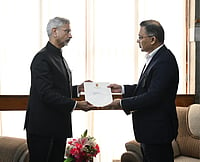High-Speed Rail (HSR) in India, or bullet trains as they are popularly known, is an idea that appeals to the aspirational upper middle class. It is high technology, world-class infrastructure and status symbol all rolled into one flashy package, a sign that India has arrived on the world stage. Given the fondness of the Modi government for grandiose projects, like the HSR Diamond Quadrilateral pledged in its election manifesto, could bullet trains become a reality in India? There needs to be a serious debate on the viability and social desirability of such a project.
International experience and the numbers involved suggest India should do some hard thinking. HSR success stories are almost all from rich, high-income countries on middle-distance (450-500 km) high-density routes, with some notable exceptions, especially China, always a special case.
Japan’s pioneering Shinkansen service has operated since the mid-’60s on the high-density Tokyo-Osaka-Kyoto route and its parameters of traffic density, distance covered and tariffs have more or less set the standard for HSR the world over. South Korea runs HSR on the Seoul-Busan corridor covering over 75 per cent of the population and around 70 per cent of both freight and passenger traffic.
HSR services in Europe connect high-density routes and have relatively high tariffs. Even in Europe, though, Spain’s ambitious HSR programme has slowed down due to the economic downturn. The UK’s HSR runs on tiny stretches and has priced itself out of an already high-tariff privatised rail market. And France, in turn, subsidises its HSR through ‘promotional fares’ to reduce tariffs and make it more socially acceptable.
In the US, after prolonged debate, two high population-density and high-employment corridors were considered in detail, namely Los Angeles-San Francisco and the northeast Philadelphia-Boston-New York-Washington DC corridor. If these clusters were countries by themselves, they’d easily rank in the top 10 nations! The California project has finally been approved at an estimated public investment of $58 billion (Rs 3.6 lakh crore).
But everyone’s favourite example is China whose HSR, like everything else in that country, is outsized and not enough is known about its inner workings. China has more than 10,000 km of HSR, introduced to take a huge leap over a poorly developed railway system covering a mere 20,000 km compared to India’s 65,000 km. Exact costs are not known, but the 968-km Wuhan-Guangzhou corridor cost around $19.4 billion. And traffic is low. The 117-km Beijing-Tianjin line currently carries 20 million passengers annually but needs 30 million to break even. China’s railway is reported to be struggling with a $318 billion debt and an annual loss of around $1.46 billion. No other country, certainly not India, has such deep pockets. High costs means high tariffs, and tariffs in China have had to be slashed to a fraction of the original due to low passenger uptake. When millions of migrant workers head home from the eastern coastal export zones for the Chinese New Year, they still travel by the extra 70,000 buses mobilised than by the bullet trains they can’t afford.
Very few sectors in the Indian rail system have the kind of passenger traffic density as the examples above. Whereas China’s HSR carries almost a third of the total 6 million rail passengers daily, ordinary Indian trains carry 12 million passengers daily (and an additional 12 million suburban passengers), about 90 per cent of whom travel in lower non-AC classes and are unlikely to afford HSR fares.
HSR in India is expected to cost around Rs 250 crore per km, implying a cost of Rs 1.2 lakh crore for the bjp’s dream Diamond Quadrilateral project. Passenger tariffs are expected to be around Rs 8 per km or Rs 3,200 for a 400 km ride on the one planned high-density line from Mumbai to Ahmedabad. Does that sound viable or what India’s masses want?
Argentina has now shifted to upgrading its existing rail network with higher-speed tracks and locomotives. This is a serious option that India can and should consider. The project will be far less expensive, will be up and running much faster, and will impact the entire rail network instead of only a few segments.
President, All India People’s Science Network & Delhi Science Forum; E-mail your columnist: raghunandan.d [AT] gmail [DOT] com


























